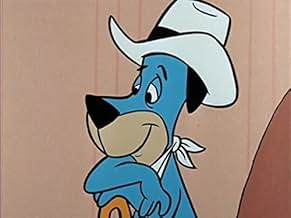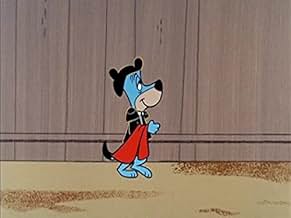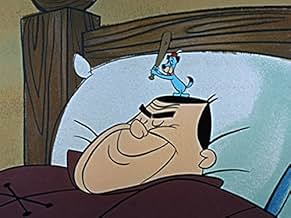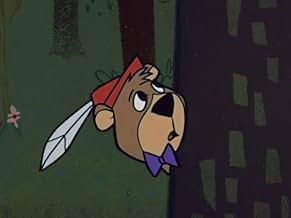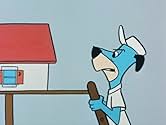The adventures of a blue dog with a southern accent.The adventures of a blue dog with a southern accent.The adventures of a blue dog with a southern accent.
- Won 1 Primetime Emmy
- 1 win & 1 nomination total
Browse episodes
Storyline
Did you know
- TriviaHuck usually broke the "fourth wall" and spoke directly to the audience.
- ConnectionsFeatured in Who Was That Lady? (1960)
Featured review
It was in the Year of Our Lord 1957 that the new company of Hanna-Barbera Productions successfully launched its very first Made-for-Television Cartoon Series. It was "RUFF & REDDY", a serialized series of adventures in the "Cliff-hanger" tradition.
The names of the two partners is in itself a play on words gag; for Ruff is the smallish brown Cat Character (voiced by Don Messick) and Reddy was the much larger gray Bulldog (voice courtesy of Daws Butler).
"THE RUFF & REDDY SHOW" was, unlike most of the other Manna-Barbera Shows quickly coming down the pike, a network show, being shown on the NBC Television web on Saturday mornings, starting in the Fall Season1957. It featured "live" or video-taped in Studio Host and some loquacious puppet birds, Rhubarb (a Parrot) and Jose (a Tucon). The presentation featured an Animated Opening Sequence which accompanied an original, peppy theme song.
With the advent of "THE HUCKLEBERRY HOUND SHOW", the format that Hanna-Barbera, as well as other Studios output of TV Syndicated Animation would follow.
Though the show bore the name of one character, the make-up each series had cartoons three different features. In case of old Huck, he shared the cartoon showing time with two other running features. The first co-feature was a cat and mouse story featuring the Cat, Mr. Jinx and two look alike, sound different Mice. "PIXIE & DIXIE"; with Dixie's wearing a plain, black vest and having a distinct Southern Drawl; with the proper speaking Pixie having a fancy, frilly bow tie & jacket! (Hmmmmm! Naw, it couldn't be, not in 1958!)
Their perennial protagonist, the cat, Mr. Jinx, spoke in a very hip, "in crowd", vernacular much like the then current "Beatniks". Old Jinksy's usual battle cry of "I hate you meeses to pieces!" Had gotten to be very familiar, and even for a time, threatened to become a deeply ingrained saying in our popular culture.
The second series was perhaps, Hanna-Barbra's greatest all-time star and surprise crowd crowd pleaser. Of course, we are referring to Yogi Bear. Yogi demonstrated what would become a common practice at Hanna-Barbera Studios of giving character development by imparting looks, names, mannerisms and voices to their stars by "borrowing" from real people. Hence, for example take Yogi Bear. He has the voice like Art Carney as Ed Norton in "THE HONEYMOONERS" and a name directly taken from NY Yankee Great, Catcher, Larry "Yogi" Berra.
At first in the earlier cartoons, Yogi was pretty much a solo act, appearing in some widely divergent story lines. Before long though, he acquired all of the trappings of which we so closely identify with him.
First of all, such an under-rated, sleeper of a rising Star would need a supporting cast and a regular setting. These all being designed to promote ease of recognition and continuity for audiences. Hence, we get the 'community' of Jellystone Park', in effect Yogi's "Home Town."
As for supporting players, short and deep voiced Boo-Boo is Yogi's bruin side kick and, in a dramatic sense, he serves as an agent for exposition and story development. He is usually the guy there to question Yogi's behaviour or his craving for 'Picanick Baskets'!
Then of course, there must be an antagonist in any on going series, if only to create a 'situation' and hence a story. Free-spirited Yogi finds his full-time 'nemisis' in that uniformed bastion of law and order, from the U.S.Department of the Interior's Forest Service, Ranger Smith.
As for Huckleberry Hound, his series was made-up of a lot of different occupations and situations in which Huck would be thrust. E.G., I.E., we could tune and find a cartoon which portrayed Mr. Hound as a Fireman, Policeman, Cowboy, Aviator, etc. With a generous contribution voice-over dialog from the narrator, Huck would be put through his paces in order to a comical view of a specific line of work. **
The humor in Huckleberry Hound usually owed its origin to the juxtaposition of a certain set of seemingly serious situations to Huck's reaction, method of solving and his slow, dry remarks about his experiences. And it was always done in a slow, deliberate, totally emotionless reply. As for his voice and certain mannerisms for the Hound, many (including this writer) believe that it was early verbal humor of Andy Griffith that was the inspiration.
In "HUCKLEBERRY HOUND" we saw that a very close identification of a TV show with sponsor still existed. And even though Huck & Friend's half hour was syndicated** to various stations in different markets (cities ), it had contracted with the very powerful, giant of the breakfast world, KELLOGG'S of Battle Creek, Michigan to be the exclusive sponsor, wherever the series found itself. As part of the deal, it is the caricature Rooster character from the Kellogg's Corn Flakes Box who finds himself animated and as active as the Huckleberry Hound lively theme song plays and is sung at the opening credits: "THE BIGGEST SHOW IN TOWN IS HUCKLEBERRY HOUND, FOR ALL YOU GUYS AND GALS .."
C'mon now, everybody sing!
NOTE: * The use of varying occupations with different situation together with such active participation by the narrator, Huck Cartoons were amazingly close to those Warner Brothers' JOE McDOAKES with George O'Hanlon (who coincidentally would provide the voice for Hanna-Barbera's "THE JETSONS".
NOTE: ** In our home town of Chicago, it was Station WGN TV, Channel 9, which aired "HUCKLEBERRY HOUND" on Wednesday evenings at 7:30 PM.
The names of the two partners is in itself a play on words gag; for Ruff is the smallish brown Cat Character (voiced by Don Messick) and Reddy was the much larger gray Bulldog (voice courtesy of Daws Butler).
"THE RUFF & REDDY SHOW" was, unlike most of the other Manna-Barbera Shows quickly coming down the pike, a network show, being shown on the NBC Television web on Saturday mornings, starting in the Fall Season1957. It featured "live" or video-taped in Studio Host and some loquacious puppet birds, Rhubarb (a Parrot) and Jose (a Tucon). The presentation featured an Animated Opening Sequence which accompanied an original, peppy theme song.
With the advent of "THE HUCKLEBERRY HOUND SHOW", the format that Hanna-Barbera, as well as other Studios output of TV Syndicated Animation would follow.
Though the show bore the name of one character, the make-up each series had cartoons three different features. In case of old Huck, he shared the cartoon showing time with two other running features. The first co-feature was a cat and mouse story featuring the Cat, Mr. Jinx and two look alike, sound different Mice. "PIXIE & DIXIE"; with Dixie's wearing a plain, black vest and having a distinct Southern Drawl; with the proper speaking Pixie having a fancy, frilly bow tie & jacket! (Hmmmmm! Naw, it couldn't be, not in 1958!)
Their perennial protagonist, the cat, Mr. Jinx, spoke in a very hip, "in crowd", vernacular much like the then current "Beatniks". Old Jinksy's usual battle cry of "I hate you meeses to pieces!" Had gotten to be very familiar, and even for a time, threatened to become a deeply ingrained saying in our popular culture.
The second series was perhaps, Hanna-Barbra's greatest all-time star and surprise crowd crowd pleaser. Of course, we are referring to Yogi Bear. Yogi demonstrated what would become a common practice at Hanna-Barbera Studios of giving character development by imparting looks, names, mannerisms and voices to their stars by "borrowing" from real people. Hence, for example take Yogi Bear. He has the voice like Art Carney as Ed Norton in "THE HONEYMOONERS" and a name directly taken from NY Yankee Great, Catcher, Larry "Yogi" Berra.
At first in the earlier cartoons, Yogi was pretty much a solo act, appearing in some widely divergent story lines. Before long though, he acquired all of the trappings of which we so closely identify with him.
First of all, such an under-rated, sleeper of a rising Star would need a supporting cast and a regular setting. These all being designed to promote ease of recognition and continuity for audiences. Hence, we get the 'community' of Jellystone Park', in effect Yogi's "Home Town."
As for supporting players, short and deep voiced Boo-Boo is Yogi's bruin side kick and, in a dramatic sense, he serves as an agent for exposition and story development. He is usually the guy there to question Yogi's behaviour or his craving for 'Picanick Baskets'!
Then of course, there must be an antagonist in any on going series, if only to create a 'situation' and hence a story. Free-spirited Yogi finds his full-time 'nemisis' in that uniformed bastion of law and order, from the U.S.Department of the Interior's Forest Service, Ranger Smith.
As for Huckleberry Hound, his series was made-up of a lot of different occupations and situations in which Huck would be thrust. E.G., I.E., we could tune and find a cartoon which portrayed Mr. Hound as a Fireman, Policeman, Cowboy, Aviator, etc. With a generous contribution voice-over dialog from the narrator, Huck would be put through his paces in order to a comical view of a specific line of work. **
The humor in Huckleberry Hound usually owed its origin to the juxtaposition of a certain set of seemingly serious situations to Huck's reaction, method of solving and his slow, dry remarks about his experiences. And it was always done in a slow, deliberate, totally emotionless reply. As for his voice and certain mannerisms for the Hound, many (including this writer) believe that it was early verbal humor of Andy Griffith that was the inspiration.
In "HUCKLEBERRY HOUND" we saw that a very close identification of a TV show with sponsor still existed. And even though Huck & Friend's half hour was syndicated** to various stations in different markets (cities ), it had contracted with the very powerful, giant of the breakfast world, KELLOGG'S of Battle Creek, Michigan to be the exclusive sponsor, wherever the series found itself. As part of the deal, it is the caricature Rooster character from the Kellogg's Corn Flakes Box who finds himself animated and as active as the Huckleberry Hound lively theme song plays and is sung at the opening credits: "THE BIGGEST SHOW IN TOWN IS HUCKLEBERRY HOUND, FOR ALL YOU GUYS AND GALS .."
C'mon now, everybody sing!
NOTE: * The use of varying occupations with different situation together with such active participation by the narrator, Huck Cartoons were amazingly close to those Warner Brothers' JOE McDOAKES with George O'Hanlon (who coincidentally would provide the voice for Hanna-Barbera's "THE JETSONS".
NOTE: ** In our home town of Chicago, it was Station WGN TV, Channel 9, which aired "HUCKLEBERRY HOUND" on Wednesday evenings at 7:30 PM.
- How many seasons does The Huckleberry Hound Show have?Powered by Alexa
Details
Contribute to this page
Suggest an edit or add missing content

Top Gap
By what name was The Huckleberry Hound Show (1958) officially released in Canada in English?
Answer

